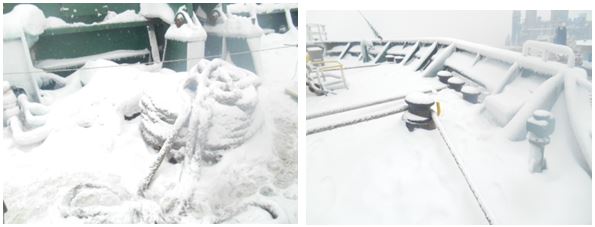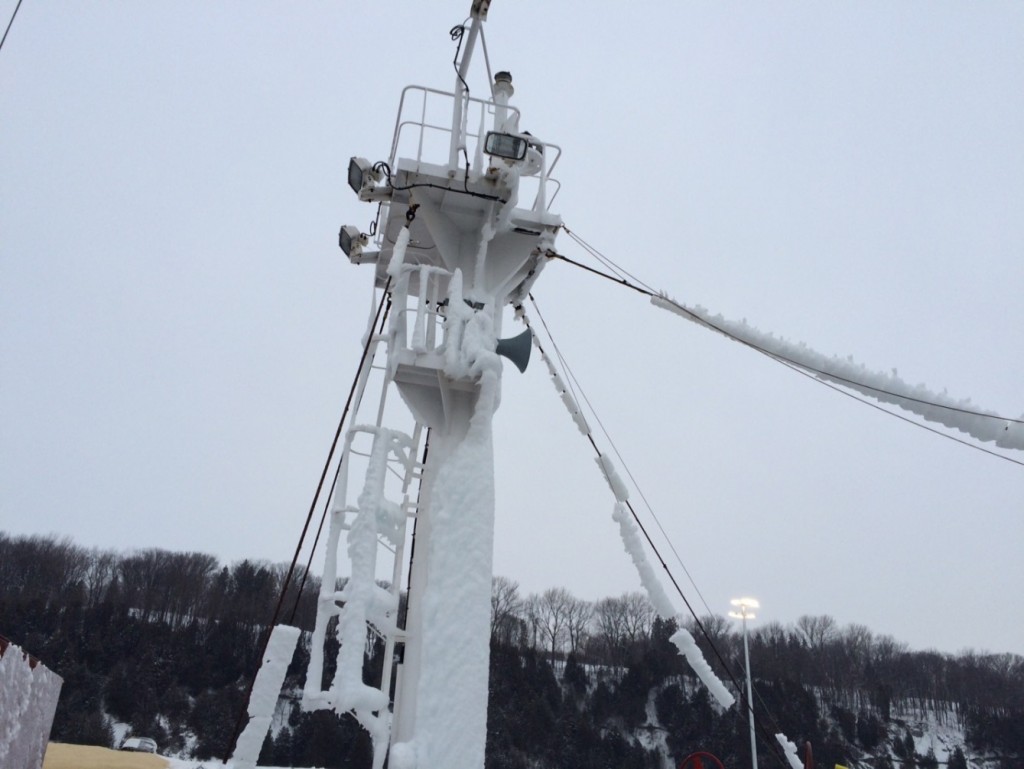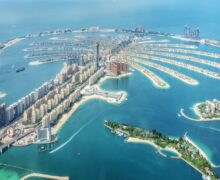
Shipboard Preparation for Ice in Winter Season – Kamal Ahmed (15)
Preparation
Prior making a voyage into subfreezing zone, Master must ensure that the vessel is suitable for navigating in that zone, crew are duly trained, well protected with PPE and necessary gears and familiar with the operations of the vessel in ice conditions. Master also need to prepare his or her vessel to encounter severe winter condition to prevent damages to the vessel and or its machinery prior entry in areas in freezing condition.
Ballasting & De-ballasting
- While pumping out Ballast Water from the Cargo Hold, there is a tendency of ice forming on the frames & girders. Consider heating holds by Electrically Operated Heaters.
- For sounding Ballast Tanks, sometimes it will be useful to blow hot air through the air pipe. It may be necessary to frequently pour Glycol or clear the sounding pipes with sounding rod.
- Ballast tanks should be maximum 90% full to allow expansion due to freezing. Care must be taken by pumping ballast in and out to ensure that the vent pipes are not blocked with ice.
- De-ballast one tank at a time. Continue stripping without any break.
Equipment & Apparatus
- At temperature below -30C, move the rudder Port & Starboard side enough to keep the Rudder Stock free.
- Propeller and Bow Thruster should be well below water.
- Anchor should be free and ready to be moved from the hawse pipe position. The pumps for Windlass and Mooring Winches should be running at all the times.
- Lifeboat Engine & Emergency Generator should be filled up with Anti-Freeze. Pay attention to fresh water tanks in life boats ( leave some void)
- Emergency fire pump suction strainer should be free of ice and the pump should be ready for use at all times.
- Make sure sea that the chest vent is not choked/frozen and its valve is left open. Never use compressed air to clear sea chest in operation as it will create an airlock in the SW cooling system.
Pipe Lines & Valves
- Fire Line should be drained out and blown with air. The anchor wash line should be drained out.
Draft Marks
- During winter, sometimes it is not possible to read the Draft Marks. It may be helpful to take the Photographs of Draft Marks for obstruction by Ice and issue a Note of Protest Letter, witnessed by the Agent.
Navigation & Maneuvering
- If the air temperature is below freezing, avoid taking head wind and sea spray which forms ice on the Fore Castle and on Deck. If necessary reduce speed. It is better to lose a few hours than a complete week in port “Off-Hire” with an expensive de-icing shore crew. There was an instance where the ship owner had to pay USD 50,000 for an Electrical Jack Hammer to break 100 cm of thick Ice from the Hatch Covers (6 men/24 hours for 2 days).
- Follow the weather routing for Insurance purpose.
- The main engine must be ready to go astern any time.
- To go astern, the rudder must be mid-ship to prevent the propeller and rudder from damage.
To prevent the hull from damage caused by impact, enter the ice at low speed and then increase to moderate speed to maintain headway and control of the ship. - Do not drop the anchor where ice is dense in order to avoid the danger of the anchor chain being cut.
Bridge & Bridge Equipment
- Ensure whistle/horn heaters remain “On” at all the times.
- Radar scanners to be kept turning all the times.
- Turn on navigation lights at all times (at sea).
Deck, Windlass, Mooring Ropes & Pilot Boarding Arrangement
- Ensure that all mooring ropes and wires on the drums are securely covered. No mooring ropes should be out at sea.
- Gangway, Pilot Hoist, Windlass, Compression Bars should be greased.
- Pilot transferring equipment and boarding procedure should be maintained.
- Manila Ropes should not be used for lashing on deck as it becomes stiff in cold temperature. Polypropylene or synthetic ropes are suitable for this type of weather.
- Deck & Muster Station must be free of Ice & Snow.
- All forward Deck fittings and Air Pipes to be covered by burlap & coated with grease mixed with Glycol.
An accumulation about 350 M/T of ice on Deck.
Crew protection
- Heating in the accommodation shall be always in working condition.
- The entire crew must be provided with proper winter clothing.
ISM Code
The ISM Code is intended to address risks associated with ship operations and establish well documented vessel specific procedures and practices. The Crew members designated to the vessel are required to possess skills and knowledge essential for the safe execution of tasks they are expected to perform in normal day to day operations and during emergency situations.
Ice-Accretion
Ice-accretion on super-structure / containers / deck-cargo /masts can seriously imperil the vessel’s stability. Sufficient GM (F) to counteract same must be maintained.
Canadian Regulations
Every Ship of 100 tons gross or over, navigating in ice covered waters of Eastern Canada must have and use the publication “Ice Navigation in Canadian Waters (TP5064).
Canadian regulations require that all vessels navigating in ice to be equipped with a system to prevent icing and chocking of sea chests and to maintain an essential cooling water supply. (Ref: Canadian Marine Machinery Regulations-SOR/90-264). Icing/blockage could occur between December to March.
Transport Canada strongly recommends to have onboard and to have all personnel knowledgeable of the following documents:
a) Winter Navigation on the River and Gulf of St. Lawrence Practical Notebook for Marine Engineers and Deck Officers (TP14335/Edition 2011)
b) Joint Industry-Government Guidelines for the Control of Oil Tankers and Bulk Chemical Carriers in Ice Control Zones of Eastern Canada (TP15163/Edition 2011).
Usful links:
http://publications.gc.ca/site/archivee-archived.html?url=http://publications.gc.ca/collections/collection_2010/tc/T29-85-2009-eng.pdf http://www.ccg-gcc.gc.ca/Icebreaking/Ice-Navigation-Canadian-Waters/Navigation-in-ice-covered-waters
Capt. Kamal Ahmed
15th Batch (N)
Port Warden, Quebec City
















Recent Comments